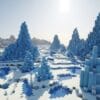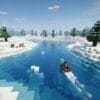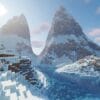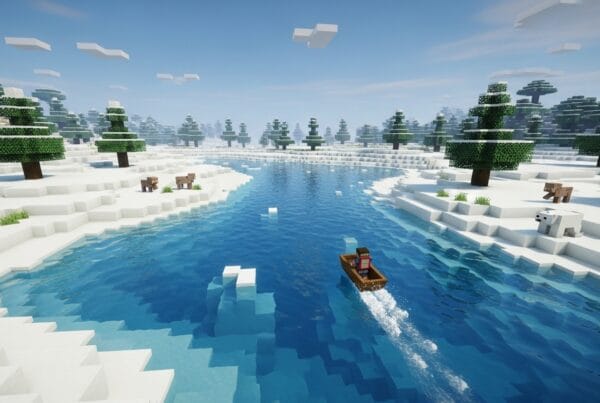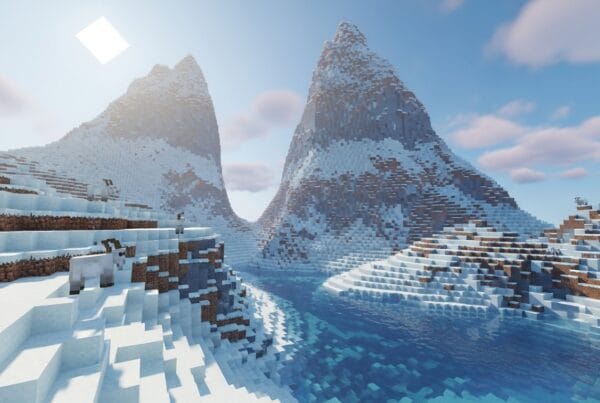The Frozen Ocean biome in Minecraft is a vast and chilly seascape filled with floating icebergs, deep blue waters, and the occasional wandering polar bear. Beneath its tranquil surface lie ruins, shipwrecks, and Ocean Monuments—making it a biome of both serenity and danger. Whether you’re an explorer searching for treasure or a builder inspired by frozen beauty, this guide covers everything you need to know about the Frozen Ocean biome and how to survive in it.
Biome Overview
The Frozen Ocean biome is one of Minecraft’s coldest and most striking environments. It combines expansive seas, scattered icebergs, and minimal vegetation to create a truly arctic experience.
- Temperature: Extremely cold; snow and ice dominate.
- Location: Commonly borders Snowy Plains, Frozen River, or Ice Spikes biomes.
- Variants:
- Frozen Ocean: Shallow waters with visible icebergs and surface ice.
- Deep Frozen Ocean: Much deeper variant, where Ocean Monuments spawn and the surface may remain unfrozen.
Terrain and Features
Icebergs and Surface Features
Icebergs are the Frozen Ocean’s most iconic feature. These structures can appear in various shapes and sizes, composed of:
- Packed Ice
- Blue Ice
- Snow Blocks
Some reach high above the waterline, while others extend deep underwater. Blue Ice is particularly prized by players—it’s slipperier than Packed Ice, making it ideal for boat highways and Redstone contraptions.
Seafloor Composition
Under the ice, you’ll find:
- Gravel
- Sand
- Clay patches
While resources are abundant, mining underwater requires tools like Doors, Respiration-enchanted helmets, or Water Breathing Potions.
Structures Found
- Ocean Monuments: Home to Guardians and valuable Prismarine blocks.
- Underwater Ruins (Cold Variants): Contain loot like enchanted fishing rods and treasure maps.
- Shipwrecks: Often frozen in place beneath the ice, holding useful loot such as emeralds, iron, and buried treasure maps.
Water Freezing and Ice Mechanics
The Frozen Ocean biome features unique freezing behavior:
- Surface water near icebergs is often replaced by ice during generation, rather than freezing dynamically.
- In most Java Edition worlds, water won’t freeze naturally at sea level, preventing oceans from turning solid.
- Deep Frozen Ocean biomes rarely generate with ice-covered surfaces.
- Players wanting to farm ice should build platforms above sea level or travel to an Ice Spikes biome for better results.
This makes Frozen Oceans excellent for ice navigation but not ideal for large-scale ice farming.
Mobs Found in the Frozen Ocean
Passive Mobs
- Polar Bears: Spawn on icebergs and snowy edges. Neutral until provoked or approached with cubs nearby.
- Cod, Salmon, and Squid: Common underwater spawns, providing easy access to fish and ink sacs.
Hostile Mobs
- Drowned: Frequent in deeper waters or around ruins; some carry Tridents, posing a significant threat.
- Guardians / Elder Guardians: Found within Ocean Monuments, guarding Prismarine and Gold Blocks.
Mob Behavior Highlights
- Polar Bears are neutral but protective—approaching cubs can trigger aggression.
- Drowned mobs have increased spawn rates in cold ocean variants, making nighttime exploration risky.
Vegetation and Flora
Unlike warmer ocean biomes, Frozen Oceans are barren underwater:
- No kelp or seagrass generates naturally, making it one of the least vegetated ocean types.
- Coral, tropical fish, and dolphins do not spawn here.
- The absence of vegetation affects both aesthetics and food sourcing, requiring players to rely more on fishing or imported crops.
Blocks and Resources
| Resource | Description | Uses |
|---|---|---|
| Packed Ice | Common in icebergs | Decoration, building, sliding surfaces |
| Blue Ice | Rare, crafted from Packed Ice | High-speed boat travel |
| Snow Blocks | Found atop icebergs | Building, snow golems |
| Gravel & Sand | Common seafloor materials | Crafting concrete and glass |
| Prismarine & Sea Lanterns | From Ocean Monuments | Building, underwater lighting |
While vegetation is minimal, loot structures often compensate with rare resources such as enchanted fishing rods, emeralds, and books.
Structures and Generation
Ocean Monuments
Exclusive to deep variants, these massive underwater structures are packed with Guardians, Elder Guardians, and valuable blocks. Players should bring:
- Water Breathing Potions
- Night Vision Potions
- Strong Armor and Weapons
Clearing a monument can yield sponges, gold blocks, and prismarine, which are essential for underwater builds.
Underwater Ruins
Cold variants feature stone brick and mossy cobblestone designs with loot chests. Drowned mobs spawn frequently here, so light the area or use Doors for safe exploration.
Shipwrecks
Shipwrecks occasionally generate beneath or inside icebergs. Loot chests may contain treasure maps, iron, and emeralds, often serving as lifelines for survival-based starts.
Exploration Tips
Exploring the Frozen Ocean safely requires preparation and strategy.
Recommended Gear
- Frost Walker Boots: Walk across ice effortlessly.
- Boats: Quick travel on frozen water.
- Water Breathing & Night Vision Potions: Essential for exploring deep ruins.
- Respiration Helmet & Aqua Affinity: Improve underwater visibility and mining speed.
Building Ideas
- Ice Fortresses: Build castles atop icebergs.
- Underwater Bases: Use glass domes or conduits for oxygen and visibility.
- Lighthouse Towers: Ideal for marking safe zones amid vast frozen seas.
Survival Strategies
Surviving in the Frozen Ocean can be tough due to limited land and resources:
- Gather Wood Early: Look for nearby taiga or shipwreck loot for logs and saplings.
- Fish for Food: Reliable early food source since crops can’t grow easily without soil.
- Set Up Base Near Icebergs: Provides visibility, elevation, and safety.
- Avoid Drowned at Night: Stay above water or light up underwater builds.
Hardcore Survival Challenge
Many players treat the Frozen Ocean as one of Minecraft’s hardest starting biomes. With scarce trees, crops, and shelter, survival depends heavily on fishing, shipwreck loot, and resource management. If you’re up for the challenge, this biome offers one of the most rewarding long-term bases.
Frozen Ocean vs Deep Frozen Ocean
| Feature | Frozen Ocean | Deep Frozen Ocean |
|---|---|---|
| Depth | Shallow to moderate | Much deeper |
| Surface Ice | Often frozen | Usually unfrozen |
| Mob Spawns | Polar Bears, Cod, Salmon, Drowned | More Drowned, Guardians, fewer Polar Bears |
| Structures | Shipwrecks, Ruins | Ocean Monuments, Ruins |
| Vegetation | Minimal | None |
| Resources | Packed Ice, Snow | Blue Ice, Prismarine |
Technical Details
- Biome ID (Java): minecraft:frozen_ocean
- Deep Variant ID: minecraft:deep_frozen_ocean
- Water Color: #3938C9
- Fog Color: #A0A0FF
- Introduced In: Minecraft 1.13 – The Update Aquatic
Finding Frozen Ocean Biomes
To locate this biome:
- Search near cold and snowy biomes on large maps.
- Look for iceberg clusters from a distance—they’re easy to spot from sea level.
- Some known seeds feature massive frozen oceans:
- Java Seed: -1456444867 – Spawns near a huge Frozen Ocean with icebergs.
- Bedrock Seed: 4004 – Begins near a snowy shore bordering a Deep Frozen Ocean.
Fun Facts and Trivia
- The Frozen Ocean biome was added in Minecraft 1.13’s Update Aquatic.
- Blue Ice lets boats move even faster than Packed Ice, creating “ice highways.”
- Polar Bears first appeared in version 1.10.
- No kelp or coral reefs generate here, making it the most barren ocean biome.
- Some icebergs contain hidden air pockets—great spots to build secret bases!
Conclusion
The Minecraft Frozen Ocean biome combines stunning scenery with harsh survival conditions. Between icebergs, polar bears, and drowned-infested waters, it challenges even experienced players. Yet, with patience, creativity, and preparation, it can become one of the most beautiful and rewarding areas to settle in the overworld.
Related Guides:
- [Deep Frozen Ocean Biome Guide]
- [Frozen River Biome Guide]
- [Ice Spikes Biome Guide]

